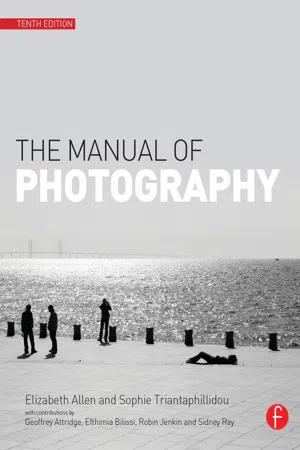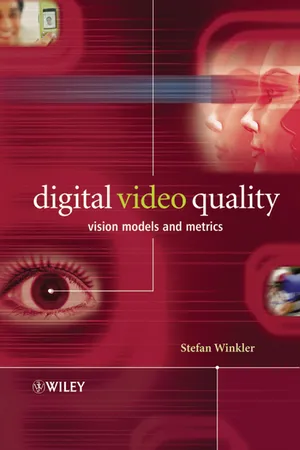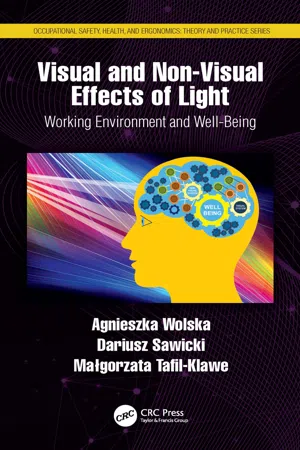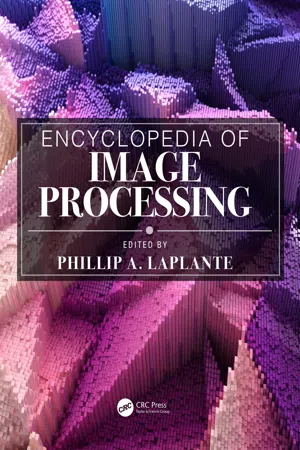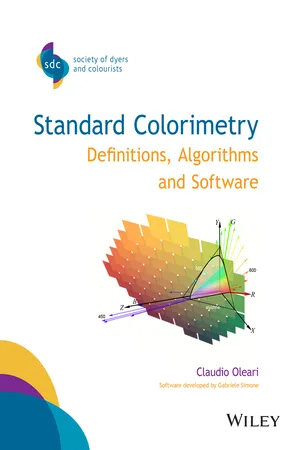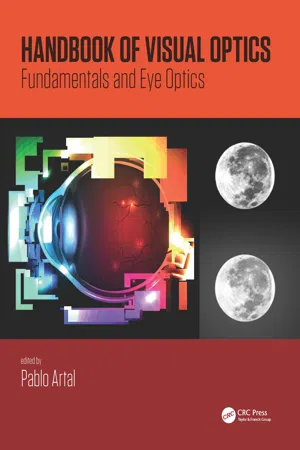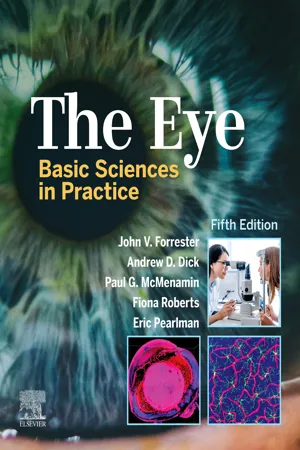Physics
Human Eyes
The human eye is a complex organ that enables vision by capturing and processing light. It consists of various parts, including the cornea, lens, and retina, which work together to focus light onto the retina and convert it into electrical signals that are sent to the brain for interpretation. The eye's ability to perceive color, depth, and detail makes it a remarkable optical instrument.
Written by Perlego with AI-assistance
Related key terms
Related key terms
1 of 4
Related key terms
1 of 3
10 Key excerpts on "Human Eyes"
- eBook - ePub
- Elizabeth Allen, Sophie Triantaphillidou(Authors)
- 2012(Publication Date)
- Routledge(Publisher)
visual cortex, leads us to perceive images approximately one- to two-tenths of a second after they occur. Understanding the basic functioning of the eye leads to better design and operation of imaging systems, whether it be matching the exit pupil of a pair of binoculars to that of the eye or designing a compression system to be perceptually lossless. The visual systems of animals display incredible variation in complexity, operation and performance. Appreciation of this wide biological diversity, from the compound eye of the bee to the polarized vision of cephalopods, inspires many further advances in numerous areas.THE PHYSICAL STRUCTURE OF THE HUMAN EYE
In brief, the eye is a light-tight sphere, approximately 24 mm in diameter, whose shape is predominantly maintained by the sclera, the white part of the eye, and the vitreous humour (Figure 4.1 ). It has a lens system positioned at the front to focus light on to a photosensitive layer, the retina, which lines the rear of the eye, to form an inverted image. The lens system consists of the cornea and a crystalline lens. It is the function of the retina to convert the incoming light to electrical signals which then travel to the visual cortex and other structures via the optic nerve at the rear of the eyeball. Processing of images, their meaning and the context within which they appear is distributed throughout various parts of the brain and not presently fully understood. The visual cortex, however, is primarily responsible for perception of patterns and shapes encoded by the retina. The coloured portion of the eye, the iris, controls the amount of light entering the visual system by changing the size of the pupil - eBook - ePub
- Michael Peres, Michael R. Peres(Authors)
- 2013(Publication Date)
- Routledge(Publisher)
Input to the visual system occurs through the eyes. The eyes are sensory organs, and their primary role is to detect light energy, code it into fundamental “bits” of visual information, and transmit it to the rest of the brain for analysis. In the higher levels of the brain, the information bits are eventually recombined to form mental images and our conscious visual perception of the world. The visual system is perhaps the most complex of all sensory systems in humans. This is evidenced by the multiplicity of brain areas devoted to vision, as well as the complexity of cellular organization and function in each of these areas.The human eye is a globe cushioned into place within a bony orbit by extraocular muscles, glands, and fat. The extra-ocular muscles move the eyes in synchrony to allow optimal capture of interesting visual information. Eye movements can be either involuntary, reflex reactions (e.g., nystagmus, convergence during accommodation), or voluntary actions. Light rays enter the eye through a circular, clear, curved cornea, which converges them into the anterior chamber of the eye (Figure 1 ). The number of light rays allowed to pass through the rest of the eye is controlled by the iris — a contractile, pigmented structure that changes in size as a function of light intensity, distance to the object of interest, and even pain or emotional status. The iris controls not only the amount of light entering the posterior chamber of the eye, but also the focal length of this light beam, and thus the overall quality of the image achievable. After the iris, light passes through the lens, a small, onion-like structure whose different layers vary in refractive index which provides final focusing power to precisely position the visual information on the retina. The retina is the most photosensitive component of the human central nervous system and covers most of the inner, back surface of the eye. Its highly regular neuronal structure is normally organized into seven cellular and fiber layers (Figure 2 - eBook - ePub
Digital Video Quality
Vision Models and Metrics
- Stefan Winkler(Author)
- 2013(Publication Date)
- Wiley(Publisher)
2
Vision
Seeing is believing. English proverbVision is the most essential of our senses; 80–90% of all neurons in the human brain are estimated to be involved in visual perception (Young, 1991). This is already an indication of the enormous complexity of the human visual system. The discussions in this chapter are necessarily limited in scope and focus mostly on aspects relevant to image and video processing. For a more detailed overview of vision, the reader is referred to the abundant literature, e.g. the excellent book by Wandell (1995).The human visual system can be subdivided into two major components: the eyes, which capture light and convert it into signals that can be understood by the nervous system, and the visual pathways in the brain, along which these signals are transmitted and processed. This chapter discusses the anatomy and physiology of these components as well as a number of phenomena of visual perception that are of particular relevance to the models and metrics discussed in this book.2.1 EYE
2.1.1 Physical Principles
From an optical point of view, the eye is the equivalent of a photographic camera. It comprises a system of lenses and a variable aperture to focus images on the light-sensitive retina. This section summarizes the basics of the optical principles of image formation (Bass et al. , 1995; Hecht, 1997).The optics of the eye rely on the physical principles of refraction . Refraction is the bending of light rays at the angulated interface of two transparent media with different refractive indices. The refractive index n of a material is the ratio of the speed of light in vacuum c 0 to the speed of light in this material c : n = C 0 /c . The degree of refraction depends on the ratio of the refractive indices of the two media as well as the angle ϕ between the incident light ray and the interface normal: n 1 sin ϕ 1 = n 2 sin ϕ 2 . This is known as Snell’s law .Lenses exploit refraction to converge or diverge light, depending on their shape. Parallel rays of light are bent outwards when passing through a concave lens and inwards when passing through a convex lens. These focusing properties of a convex lens can be used for image formation. Due to the nature of the projection, the image produced by the lens is reversed, i.e. rotated 180° about the optical axis. - eBook - ePub
Visual and Non-Visual Effects of Light
Working Environment and Well-Being
- Agnieszka Wolska, Dariusz Sawicki, Małgorzata Tafil-Klawe(Authors)
- 2020(Publication Date)
- CRC Press(Publisher)
2 The Biological Bases of Photoreception in the Process of Image VisionA vision is not just a picture of what could be; it is an appeal to our better selves, a call to become something more. Rosabeth Moss Kanter2.1 Optics of the Eye – From the Pupil to the Retina
Numerous studies have been devoted to vision and visual perception in human beings. Though far from easy, it is important to understand the complex and still not entirely discovered workings of sight. The following chapter will try to elucidate the biology of photoreception in the process of image vision.Figure 2.1 provides a diagram showing a schematic cross-section of the human eye (A) and the morphology of the retina (B). Light enters the eye through the cornea (a transparent external surface) and passes through the pupil (the aperture that allows it in). The diameter of the pupil is controlled by the muscles of the iris so that an optimum amount of light can be let in under different conditions. Behind the iris lies the crystalline lens focusing the incoming light on the retina. Thus, the eye can be compared to a photographic camera: it has a variable aperture system (the pupil), a lens system, and a retina that corresponds to the film.FIGURE 2.1 Cross-section of the human eye (A) and morphology of the retina (B).The amount of light entering the eye through the pupil is proportional to its area. The pupil diameter in the human eye can vary from 1.5 mm to 8 mm and is regulated by the iris, whose major function is to admit more light in the dark and less in daylight. The variations in the pupil’s aperture make it capable of allowing 30-fold changes in how much light enters the eye.The lens has just the right curvature for parallel rays of light to pass through each of its parts and be bent exactly enough for all the rays to pass through a single focal point. The more a lens bends the light rays, the greater is its refractive power measured in terms of diopters. In children, this refractive power can be increased from 20 diopters to about 34 diopters, which is an accommodation of about 14 diopters. The elastic lens capsule can change shape (become more or less spherical) in response to the activity of the ciliary muscle, controlled by the autonomic nervous system. This refractive power influences visual acuity, or clarity of vision – in the human eye it is about 25 seconds of arc for discriminating between point sources of light. A person with normal visual acuity looking at two pinpoint light spots 10 m away can barely distinguish the separate spots when they are 1.5 to 2 mm apart. - eBook - ePub
- Phillip A. Laplante, Phillip A. Laplante(Authors)
- 2018(Publication Date)
- CRC Press(Publisher)
10 ] The eyes sit in sockets that allow them to rotate, a feature that is useful for two reasons. First, it allows features of interest to be projected onto the fovea where vision has the highest acuity. Second, it allows humans to follow moving objects without head movement.Figure 2 shows an annotated cross section of the human eye. Light enters the eye through the pupil, travels through the ocular media, and finally hits the retina. The retina is a layer of neural sensors lining the back of the eye. These sensors transduce light into a signal that is transmitted to the brain. Several layers of neurons are present in the retina (shown in Fig. 3 ). Only the photoreceptors (i.e., the rods and cones) are sensitive to light.Fig. 2 A simplified cross section of the human eyeSource : Adapted from Ref. [10 ].Fig. 3 The human retina consists of several layers of neurons that mediate visionSource : Adapted from Ref. [19 ].Optical Media and the Retina
Light enters the eye through the cornea and then passes through the aqueous humor, a cavity filled with clear liquid, before reaching the iris and the lens. The visual field over which light can enter the eye extends to about 60 degrees nasally and 95 degrees temporally. Vertically, the field of view extends 60 degrees above and 75 degrees below the horizontal meridian. Both eyes together therefore achieve a field of view of almost 180 degrees.The iris contains muscles to control the diameter of the pupil and thereby helps regulate how much light passes through.a The lens is attached to muscles that control its shape and is used to focus on objects located at different distances to the eye. Note, however, that the cornea performs most of the focusing due to its curvature and refractive index (n = 1.376), while the lens contributes the remainder.[3 ]After passing through the lens, light traverses the vitreous humor before reaching the retina, a neurosensory layer able to transduce light into signals and transmit those to the brain. The retina consists of several layers of cells as well as several regions with different properties. Light first passes through all layers of the retina before being transduced by the photoreceptors. The photoreceptors pass their electrical signal to a layer of bipolar cells, which in turn transmit the signal to the ganglion cells. Although the ganglion cells are located in the retina, they synapse in the LGN. Their axons are collectively called the optic nerve bundle - eBook - ePub
Standard Colorimetry
Definitions, Algorithms and Software
- Claudio Oleari(Author)
- 2015(Publication Date)
- Wiley(Publisher)
tissues, the outside part of the nervous system, in which occurs the transduction of the luminous flux into a nerve signal. Transduction is a photochemical phenomenon and, as such, is a quantum phenomenon and the nervous signal, generated in this process, is due to the number of photons (light quanta) absorbed by the photosensitive cells of the retina. In the retina, nerve cells with a complex processing of the nerve signals resulting from the transduction of the photoreceptors, produce the signal to be transmitted to the brain through the optic nerve.The signals pass from the retina to the brain, where there are different places intended to treat the various aspects of vision. The correspondence between the colour sensations and colour stimuli is obtained by applying the tools of physiology and psycho-physical analysis.This chapter- invokes those concepts of optics that are required to describe the activation of the visual system and
- describes the anatomy and physiology of the visual system.
5.2 Eye Anatomy and Optical Image Formation
The eye is the organ of vision that has the structure of a camera, with an objective lens and a surface sensitive to the light, the retina.The role of the eye is comparable with that of a photographic camera, even if with many fundamental differences (Figure 5.1 - eBook - ePub
- Mark D. Fairchild(Author)
- 2013(Publication Date)
- Wiley(Publisher)
e.g ., CCD) of a camera. These and other structures have a significant impact on our perception of color.Figure 1.1 Schematic diagram of the human eye with some key structures labeledThe CorneaThe cornea is the transparent outer surface of the front of the eye through which light passes. It serves as the most significant image-forming element of the eye since its curved surface at the interface with air represents the largest change in index of refraction within the eye’s optical system. The cornea is avascular, receiving its nutrients from marginal blood vessels and the fluids surrounding it. Refractive errors, such as nearsightedness (myopia), farsightedness (hyperopia), or astigmatism, can be attributed to variations in the shape of the cornea with respect to the location and the shape of the retina. These refractive errors are sometimes corrected with laser surgery to reshape the cornea.The LensThe lens serves the function of accommodation. It is a layered, flexible structure that varies in index of refraction. It is a naturally occurring gradient-index optical element with the index of refraction higher in the center of the lens than at the edges. This feature serves to reduce some of the aberrations that might normally be present in a simple optical system.The shape of the lens is controlled by the ciliary muscles. When we gaze at a nearby object, the lens becomes “fatter” and thus has increased optical power to allow us to focus on the near object. When we gaze at a distant object, the lens becomes “flatter” resulting in the decreased optical power required to bring more distant objects into sharp focus. As we age, the internal structure of the lens changes, resulting in a loss of flexibility. Generally, when the age of about 45–50 years is reached, the lens has completely lost its flexibility and observers can no longer focus on near objects (this is called presbyopia, or “old eye”). It is at this point that most people must resort to reading glasses or bifocals. - eBook - ePub
Visual Perception
An Introduction, 3rd Edition
- Nicholas Wade, Mike Swanston(Authors)
- 2013(Publication Date)
- Psychology Press(Publisher)
Figure 4.18 ). The retinal receptors contain light-sensitive pigments that are modified chemically by absorbing light. However, unlike receptors in other senses they hyperpolarise when light falls on them: the potential difference between the inside and outside of the receptor cells increases. Before describing the physiological processes at the retinal level, a little more should be said about the structure of the retina itself.The retina is an outgrowth of the CNS and the receptors are directed towards the back of the eye. Therefore, before the light strikes the receptors it passes through the various neural structures in the retina and also the blood vessels that supply them. There are two types of receptor in the human retina, and they are called rods and cones because of their appearance under the microscope; rods have a cylindrical outer segment (which contains the photosensitive pigment molecules) and cones have tapered outer segments. The retina is estimated to consist of about 130 million receptors, the vast majority (over 120 million) of which are rods with about 6 million cones. The distributions of the rods and cones differ in a systematic way. The cones are concentrated in and around a central region of the retina, where there is a shallow depression, called the fovea. There are decreasing numbers of cones as the distance from the fovea increases, and there are none in the peripheral regions of the retina (Figure 4.19 ).Figure 4.19 Distribution of rods and cones over a horizontal region of the retina passing through the fovea and blind spot.One part of each eye is devoid of any receptors, and it is called the blind spot (or optic disc). It is located about 17 deg towards the nasal side of each fovea, and it is the exit pathway of the nerves from the retina (the optic nerve), as well as the region where the arteries enter and veins leave the eye. We are usually unaware of this small area of blindness in each eye, because it corresponds to different parts of the visual field of each eye. Even when we use one eye alone we generally overlook this blind spot, and it is only when we employ some specific procedure, like following the instructions to observe Figure 4.20 that we can locate it. - eBook - ePub
- Pablo Artal, Pablo Artal(Authors)
- 2017(Publication Date)
- CRC Press(Publisher)
histological optics . Insofar as it transmits light unimpeded, eye tissue, such as the cornea and the crystalline lens, needs to have unusual biological structure. This became more evident and constituted a challenge around the middle of the century when electron microscopy began to reveal the subcellular makeup of corneal and lenticular layers. The pioneering study by David Maurice (1957) on the cornea was influential here.The final biological stage of light capture resides in the receptors. Starting with an observation by Ernst Brücke in the 1840s, there have been consistent attempts to assign to them special light-gathering properties. The directional sensitivity and wave guide nature of retinal receptors has been an active area now for the last 80 years. It may be noted parenthetically that the optics of invertebrate eyes, left out of consideration in this review, has deservedly been given much attention (Exner 1891, Snyder and Menzel 1975, Land and Nilsson 2002).1.2 THE FOUNDATIONSThe eye’s image-forming properties were well understood in the middle of the eighteenth century as shown in the classic treatise by Robert Smith (1689–1768) (Smith 1738). Through the efforts of astronomers, for example, Bessel, Seidel, and Airy (1801–1892), optics as a discipline was thoroughly established in the nineteenth century. Maxwell’s (1831–1879) electromagnetic theory took command of the subject in 1861 and has never needed superseding. The giants of physiological optics, Thomas Young (1773–1839), Jan Purkinje (1787–1869), Listing (1808–1882), and Helmholtz (1821–1894), laid and cemented the foundations, and ophthalmologists Donders (1818–1889), Landolt (1846–1926), and Snellen (1834–1908) developed clinical applications. Thus, a century ago, at the time of the beginning of the First World War, a student had available comprehensive compendia containing the available knowledge, specifically Helmholtz’s Physiological Optics in the new edition updated in particular by Gullstrand (1862–1930), the Graefe-Saemisch Handbuch der Augenheilkunde in its many volumes and several editions, followed in the next couple of decades by important chapters in Vol XII of Bethe et al., Handbuch der normalen und pathologischen Physiologie (1932) and in Abderhalden’s Handbuch (1920), and in Vol 1 of Duke-Elder’s Textbook of Ophthalmology (1932). When the author entered optometry school in 1940, the assigned textbook, the second edition of Emsley’s Visual Optics - eBook - ePub
- John V. Forrester, Andrew D. Dick, Paul G McMenamin, Fiona Roberts, Eric Pearlman(Authors)
- 2020(Publication Date)
- Elsevier(Publisher)
eFig. 5.4 ). The effect of this refractive property of the ocular media (i.e. the tissues through which the light passes) is to focus light rays on the retina, and specifically the fovea, when visual acuity is being measured. Many refractive errors occur in the healthy population, including myopia (short-sightedness), hyperopia (long-sightedness) and astigmatism (non-spherical aberrations of the eye’s refractive power).The scientific discipline dealing with the optics of the eye is known as optometry. Many textbooks discuss physiological optics in addition to optical devices such as spectacle correction, contact lenses and the optics of intraocular lenses. There are large treatises that deal in depth with physiological optics and shorter text books that summarize refraction and refractive errors for those not intending a career in optometry.The reader is referred to the following texts as examples of (1) short comprehensive practical texts and (2) a three-volume in-depth treatise:- (1) Hunter DG, West MD. Last-minute optics: a concise review of optics, refraction, and contact lenses. 2010 (Also available online as podcasts and U-tube video presentation); Thorington, J. Refraction and How to Refract : (2016)
- (2) von Helmholtz H. Treatise on Physiological Optics , vols I, II and III. Dover Phoenix Editions; 2005
In addition, several texts are available that deal with the optics of the pseudophakic eye (i.e. the eye with a prosthetic intraocular lens), including official publications of professional bodies such as the American Academy of Optometry and the British College of Optometry.eFig. 5.4 Standard dimensions of the eye as related to the model eye. From Hecht, 1987.Limits of and limitations on acuity
The letters on reading charts such as the Snellen test type and the ETDRS chart (Box 5.3
Index pages curate the most relevant extracts from our library of academic textbooks. They’ve been created using an in-house natural language model (NLM), each adding context and meaning to key research topics.
Explore more topic indexes
Explore more topic indexes
1 of 6
Explore more topic indexes
1 of 4
